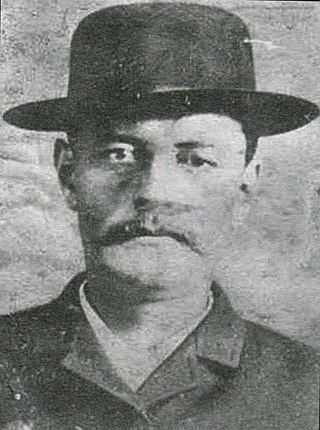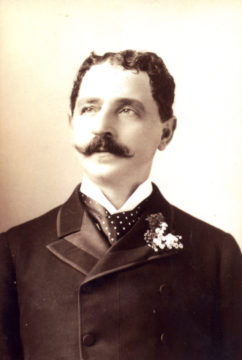
Kerman is a city at the intersection of State Route 180 and State Route 145 in Fresno County, California, United States. The population was 13,544 at the 2010 census. Kerman is located 15 miles (24 km) west of Fresno, at an elevation of 220 feet (67 m).

Visalia is a city in the agricultural San Joaquin Valley of California. The population was 141,384 as per the 2020 census. Visalia is the fifth-largest city in the San Joaquin Valley, the 40th most populous in California, and 192nd in the United States. As the county seat of Tulare County, Visalia serves as the economic and governmental center to one of the most productive agricultural counties in the country.

Wyatt Berry Stapp Earp was an American lawman in the American West, including Dodge City, Deadwood, and Tombstone. Earp was involved in the gunfight at the O.K. Corral, during which lawmen killed three outlaw Cochise County Cowboys. While Wyatt is often depicted as the key figure in the shootout, his brother Virgil was both Deputy U.S. Marshal and Tombstone City Marshal that day and had considerably more experience in law enforcement as a sheriff, constable, and marshal than did Wyatt. Virgil made the decision to enforce a city ordinance prohibiting carrying weapons in town and to disarm the Cowboys. Wyatt was only a temporary assistant marshal to his brother.

Virgil Walter Earp was an American lawman. He was both deputy U.S. Marshal and City Marshal of Tombstone, Arizona, when he led his younger brothers Wyatt and Morgan, and Doc Holliday, in a confrontation with outlaw Cowboys at the Gunfight at the O.K. Corral on October 26, 1881. They killed brothers Tom and Frank McLaury and Billy Clanton. All three Earp brothers had been the target of repeated death threats made by the Cowboys who were upset by the Earps' interference in their illegal activities. All four lawmen were charged with murder by Ike Clanton, who had run from the gunfight. During a month-long preliminary hearing, Judge Wells Spicer exonerated the men, concluding they had been performing their duty.

The California National Guard is part of the National Guard of the United States, a dual federal-state military reserve force. The CA National Guard has three components: the CA Army National Guard, CA Air National Guard, and CA State Guard. With a total strength of over 24,000 troops, it is the largest National Guard in the United States. As of January 2012, California National Guardsmen have been deployed overseas more than 38,000 times since 2001, during which time twenty-nine Guardsmen have been killed in Iraq and two have died in Afghanistan.

The San Francisco Sheriff's Office (SFSO), officially the City and County of San Francisco Sheriff's Office, is the sheriff's office for the City and County of San Francisco. The current sheriff is Paul Miyamoto. The department has 850 deputized personnel and support staff. The SFSO is a separate organization from the San Francisco Police Department. However, SFSO deputies and SFPD officers have all attended a POST-mandated police academy, and are duly sworn California peace officers.

Christopher Evans, a native of Bells Corners near Ottawa, Canada West, was an American farmer and teamster turned outlaw. He was the leader of the Evans-Sontag Gang.

Thomas Fitch was an American lawyer and politician. He defended President Brigham Young of the Church of Jesus Christ of Latter-day Saints and other church leaders when Young and his denomination were prosecuted for polygamy in 1871 and 1872. He also successfully defended Virgil, Morgan and Wyatt Earp along with Doc Holliday when they were accused of murdering Billy Clanton, Tom and Frank McLaury during the Gunfight at the O.K. Corral on October 26, 1881.

Nicholas Porter Earp was the father of well-known Western lawmen Virgil, Wyatt, and Morgan, and their lesser-known brothers James, Newton and Warren Earp. He was a justice of the peace, a farmer, cooper, constable, bootlegger, wagon-master, and teacher.
Lewis "Lew" Baker was a Welsh-American patrolman in the New York Police Department who was simultaneously employed as a "slugger" for Tammany Hall. He was involved in voter intimidation and election fraud during the 1840s and 1850s. A close friend and associate of Irish mob boss John Morrissey, Baker frequently battled supporters of the nativist Know-Nothing movement for over a decade. He is most remembered however as the assassin of William "Bill the Butcher" Poole. Baker shot and killed Poole in a Broadway saloon during a brawl. Both Baker and Morrissey were placed on trial for murder, but were acquitted.

James "Old Jimmy" Hope was a 19th-century American burglar, bank robber and underworld figure in Philadelphia and later New York City. He was considered one of the most successful and sought after bank burglars in the United States during his lifetime as well as a skilled escape artist for his repeated breakouts from Auburn State Prison in New York.

Edward H. Morrell was an American convict, activist, and writer.

Truly Shattuck was a soubrette star of vaudeville, music halls, and Broadway whose career began in tragedy and ended in relative obscurity.

John Sontag was an outlaw of the American West known for train robberies.

George C. Contant, aka George Sontag, was an outlaw of the American West known mostly for train robberies. Like his older brother, John Sontag, he was originally from Mankato, Minnesota.

Maurice Curtis, stage name M. B. Curtis, was an American stage actor, producer, and real estate developer, at one point tried and acquitted of a policeman's murder. He achieved fame in the title role of George H. Jessop's 1881 play Sam'l of Posen; or, The Commercial Drummer.

Mary Edith Fly was a late 19th and early 20th century American photographer who co-founded and managed Fly's Photography Gallery in Tombstone, Arizona, with her husband, photographer C.S. "Buck" Fly. She ran the studio alone after his death in 1901. There were few women photographers in this period, and her contributions were recognized in 1989 when she was inducted into the Arizona Women's Hall of Fame.

Belle Cora, also known as Arabella Ryan, was a madam of the Barbary Coast of San Francisco during the mid-nineteenth century. She rose to public attention in 1855 when her lover, Charles Cora, killed U.S. Marshal William H. Richardson after they had a conflict at the theater. She died in 1862.
The history of the Southern Pacific ("SP") stretched from 1865 to 1998.

















